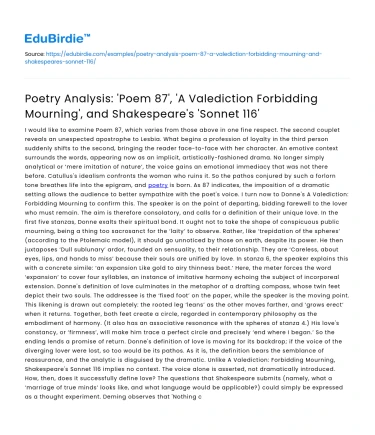I would like to examine Poem 87, which varies from those above in one fine respect. The second couplet reveals an unexpected apostrophe to Lesbia. What begins a profession of loyalty in the third person suddenly shifts to the second, bringing the reader face-to-face with her character. An emotive context surrounds the words, appearing now as an implicit, artistically-fashioned drama. No longer simply analytical or ‘mere imitation of nature’, the voice gains an emotional immediacy that was not there before. Catullus's idealism confronts the woman who ruins it. So the pathos conjured by such a forlorn tone breathes life into the epigram, and poetry is born.
As 87 indicates, the imposition of a dramatic setting allows the audience to better sympathize with the poet's voice. I turn now to Donne's A Valediction: Forbidding Mourning to confirm this. The speaker is on the point of departing, bidding farewell to the lover who must remain. The aim is therefore consolatory, and calls for a definition of their unique love. In the first five stanzas, Donne exalts their spiritual bond. It ought not to take the shape of conspicuous public mourning, being a thing too sacrosanct for the ‘laity’ to observe. Rather, like ‘trepidation of the spheres’ (according to the Ptolemaic model), it should go unnoticed by those on earth, despite its power. He then juxtaposes ‘Dull sublunary’ ardor, founded on sensuality, to their relationship. They are ‘Careless, about eyes, lips, and hands to miss’ because their souls are unified by love. In stanza 6, the speaker explains this with a concrete simile: ‘an expansion Like gold to airy thinness beat.’ Here, the meter forces the word ‘expansion’ to cover four syllables, an instance of imitative harmony echoing the subject of incorporeal extension. Donne's definition of love culminates in the metaphor of a drafting compass, whose twin feet depict their two souls. The addressee is the ‘fixed foot’ on the paper, while the speaker is the moving point. This likening is drawn out completely: the rooted leg ‘leans’ as the other moves farther, and ‘grows erect’ when it returns. Together, both feet create a circle, regarded in contemporary philosophy as the embodiment of harmony. (It also has an associative resonance with the spheres of stanza 4.) His love's constancy, or ‘firmness’, will make him trace a perfect circle and precisely ‘end where I began.’ So the ending lends a promise of return. Donne's definition of love is moving for its backdrop; if the voice of the diverging lover were lost, so too would be its pathos. As it is, the definition bears the semblance of reassurance, and the analytic is disguised by the dramatic.
Unlike A Valediction: Forbidding Mourning, Shakespeare's Sonnet 116 implies no context. The voice alone is asserted, not dramatically introduced. How, then, does it successfully define love? The questions that Shakespeare submits (namely, what a ‘marriage of true minds’ looks like, and what language would be applicable?) could simply be expressed as a thought experiment. Deming observes that 'Nothing characterizes the perfect union that Renaissance love poets hope to create so well as their desire to know what love is and to know that theirs is, in Donne's words, a 'firm substantial love.'' As Shakespeare frames the matter, love is not true if it yields to external pressure; thus, the union shaken by ‘impediments’ (a vibrant word from the solemnization of matrimony in The Book of Common Prayer) would be problematic from its outset. However, Sonnet 116 is more than just analysis. Post asserts that ‘the terms are general enough to allow considerable latitude for interpretation, but however rarified love seems’ the urgency of address ('Let me not'), the speaker's absolute sense of conviction ('Love is not love'), seems to deny the premise that the poet is simply producing an abstract definition of love.' He is rather, like an interned Richard II, untangling his thoughts. So Shakespeare, by whose prominence of voice a sense of audience is evoked, successfully relates his interpretation of love.






 Stuck on your essay?
Stuck on your essay?

